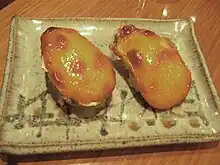
Motoyaki is a style of cooking, involving baked food topped with a mayonnaise-based sauce and served in an oyster shell.[1] It is typically available in Japanese restaurants on the Pacific coast of Canada.[2] Examples of motoyaki dishes are oyster motoyaki[1] and lobster motoyaki.[3]
In Japan
In Japanese cuisine, a sauce called tamagonomoto (卵の素, literally:basis of egg)[4][upper-alpha 1] (or tamagonomoto (玉子の素)[5] / tamamoto (玉素)[6]) is prepared by beating egg yolks and oil together just like mayonnaise, but without any vinegar.[4] Some variants also have miso[7] or soy sauce[6] added. Foods topped with this sauce and baked are moto-yaki (もと焼き)[7][upper-alpha 2] (or tamamoto-yaki (玉素焼き, literally:tamamotoed-and-baked)[8] / moto-yaki (素焼き)[6][upper-alpha 3]). Although motoyaki is considered a traditional Japanese dish,[6] the names motoyaki, tamagonomoto, and alike are not well known in Japan as of 2021, while its variant using mayonnaise: mayonēzu-yaki (マヨネーズ焼き) (or mayo-yaki (マヨ焼き)) is far more popular.[9]
Canadian motoyaki is similar to Japanese mayonēzuyaki in using mayonnaise, unlike Japanese "motoyaki".
Footnotes
- ↑ The sauce is egg-based, but its name means the opposite: "egg's base".
- ↑ The first letters "も" and "と" both have Japanese particles using the same letters, a potential cause of confusion.
- ↑ The same kanji spelling has two other homonyms, even within the context of food related words, a potential cause of confusion: す‐やき【素焼】. Nihon Kokugo Daijiten, Concise edition (in Japanese). Japan: Shogakukan. Retrieved 2021-07-20 – via Kotobank.
- 素焼き(すやき, suyaki): unglazed earthenware
- 素焼き(すやき, suyaki): unseasoned baking
References
- 1 2 Petkau, Brent (2019-03-01). "Oysters motoyaki". #BeShellfish for BC Oysters. Canada: BC shellfish growers association. Archived from the original on 2020-11-30. Retrieved 2021-07-20. (a better photo )
- ↑ Examples: "snapshot of tripadvisor.com search "motoyaki" worldwide". Tripadvisor. Archived from the original on 2021-07-20. Retrieved 2021-07-20.
- ↑ Yu, Jenice (2015-06-10). "Lobster Motoyaki Recipe". BCLiving. Archived from the original on 2021-07-20. Retrieved 2021-07-20.
- 1 2 "Tamagonomoto" 卵の素. Tsuji Culinary Institute recipes (in Japanese). Tsuji Culinary Institute. Archived from the original on 2021-07-20. Retrieved 2021-07-20.
- ↑ Tamura, Takashi (2019-01-17). レンコンの海老はさみ揚げ [fried lotus roots with shrimp surimi]. Chef Tamura's special lecture (in Japanese). Tsukuba Gakuin University. Archived from the original on 2021-07-20. Retrieved 2021-07-20.
- 1 2 3 4 山海の美味を納得の価格で味わう和食店 東京・浅草 [A traditional Japanese restaurant where you can enjoy natural gourment in reasonable price – in Asakusa, Tokyo]. NIKKEI STYLE (in Japanese). Nikkei, Inc. 2020-04-06. p. 3. Archived from the original on 2021-07-20. Retrieved 2021-07-20. (No photos of motoyaki in this article.)
- 1 2 ほたてのレシピ [Recipes for scallops]. 青森県漁業協同組合連合会 (Aomori fishers' cooperations' association) (in Japanese). もと焼き (motoyaki). Archived from the original on 2021-07-20. Retrieved 2021-07-20.
(rough translation) Ingredients of tamagonomoto: 2 egg yolks; 1 tbsp miso; 1 tbsp sugar; salt; pepper
- ↑ "tamamoto-yaki" 玉素焼き. Official blog of Robin (a Japanese restaurant) (in Japanese). 2019-07-19. Archived from the original on 2021-07-20. Retrieved 2021-07-20.
- ↑ Snapshots of searches in "Recipes search". LettuceClub (in Japanese). Kadokawa Corporation. Retrieved 2021-07-20., a Japanese recipe magazine.